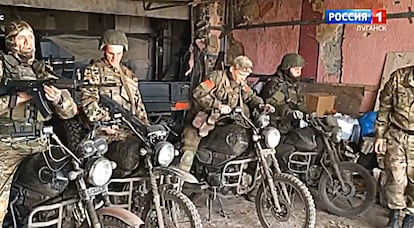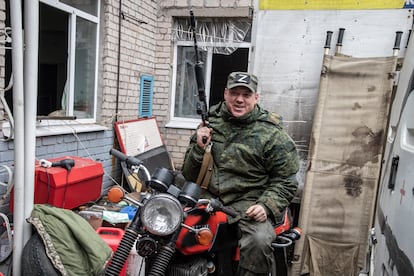Russian army develops motorcycle assault units to carry out lightning attacks on the front lines
Ukrainian soldiers warn that the invading forces are gaining positions through the use of these vehicles, which are more difficult to identify and intercept


Andrii gets off his motorcycle in the Ukrainian town of Pokrovsk to pick up supplies to take to his unit on the front line. Andrii is a soldier in the 3rd Assault Brigade and his motorcycle is his most valuable asset. It is a BMW, ideal for mountain roads, and he uses it for moving equipment between frontline battle positions in this sector of the Donetsk province. Andrii and his men are an exception. The Armed Forces of Ukraine are not replicating what this military veteran considers “clear enemy progress”: the introduction of motorcycles as rapid assault cavalry.
The Ukraine war has evolved into a conflict in which any movement is determined by the massive presence of frontline explosive and surveillance drones. More and more small vehicles are coming into action to the detriment of the slower, more identifiable armored infantry carriers. In interviews conducted by this newspaper two weeks ago on the Pokrovsk front, three different battalions provided as an example of the change the process of the evacuation of wounded soldiers: now it can only be carried out at night and mostly in small vehicles such as buggies.
Ukrainian military analysts and those of its Western allies have noted the leap forward that has taken place with these vehicles since last April in the Russian army. Videos broadcast by Russian media and online military accounts show a large fleet of motorcycles at regimental bases such as the 123rd Motorized Rifle Brigade in Donetsk or the 71st Motorized Rifle Regiment on the Zaporizhzhia front. In the latter case, images released by its personnel show motorcycles on which metal cages have been installed to protect the crew members from drone attacks. Russian soldiers have recommended in recent months via their Telegram accounts that electric motorcycles be used, because they are silent and are harder for drones with thermal night vision to detect.
“Motorcycles are a good tactic because they are harder for drones to intercept, they are less noisy and faster than armored vehicles or SUVs,” says Andrii. “The Russians are using them in large numbers and they are getting better.” In another sector of the Donetsk front, in Kostiantynivka, a sergeant with the 93rd Mechanized Brigade confirmed the tactical change to EL PAÍS on June 8: “The Russians have everything for infantry transport, and now they have motorcycles. These are the worst, because they are difficult to detect and our men cannot identify what that distant noise is.”
The patterns of action of these Russian units that have been detected, the soldiers of the 93rd Brigade and the 3rd Brigade agree, is the same: groups of eight soldiers from professional assault units ride four motorcycles, leaving at dusk or at night and, undetected, reach their front-line trench or directly attack Ukrainian positions. Rob Lee, a military expert at the U.S. Foreign Policy Research Institute, corroborated last April on his X account that the advantage of the motorcycles “is that they get to the trenches earlier and are harder to locate.” “Assaults,” Lee added, “are staged in coordination with artillery and FPV drones [those with a camera that guides the pilot].”
Andrii says the Russians are also using quads and describes a successful assault in May on the Pokrovsk front: 11 Russian quads, carrying four men each, managed to cross the Ukrainian first line of defense undetected. From behind and by surprise, they dealt a heavy blow to the soldiers of the brigade defending that sector.

More vulnerable
Not everyone thinks the use of motorcycles is such a good idea, because they are also more vulnerable and unstable. Lincoln, the code name of the commander of a Ukrainian tank company on the Bakhmut and Chasiv Yar front, assessed the situation on May 29 in the media outlet Censor Net: “The Russians are carrying out assaults with buggies and motorcycles. I can’t imagine how motivated you must be to do this. A conscientious person knows that 90% of them will end up being 200 [military terminology for being killed in action].”
Militarnyi, a Ukrainian media outlet specializing in military information, concluded that it is unclear whether the vulnerability of the motorcycles compensates for their use: “Their speed makes it possible to reduce the time they are in the open, minimizing the possibility of being detected and destroyed. But, despite their speed and maneuverability, they are often easy targets for drones and artillery, and due to their lack of protection, their crew members’ chances of survival are minimal.” Multiple videos of motorcycles destroyed by drones are circulating on social networks, but also of groups of these vehicles dodging explosions more easily than armored vehicles or SUVs.
Andrii, of the 3rd Assault Brigade, is in no doubt that the Ukrainian army should incorporate the use of motorcycles, if not to attack — the Ukrainians are currently on a defensive footing — then to move more safely to frontline positions. Ukraine had maintained the lead in resource innovation in the war until the second half of 2023. The Ukrainian army follows NATO standards, which encourages autonomous decision-making by units from company level upwards.
Russia now outperforms the Ukrainian army in all areas, and Andrii believes this is because the military power of the Russian state is now running at full speed: “Our SUVs, our drones, we either have them because they come from private donation campaigns, or we have paid for them ourselves. It will be the same if we want motorcycles; the government won’t bring them to us.”
Sign up for our weekly newsletter to get more English-language news coverage from EL PAÍS USA Edition
Tu suscripción se está usando en otro dispositivo
¿Quieres añadir otro usuario a tu suscripción?
Si continúas leyendo en este dispositivo, no se podrá leer en el otro.
FlechaTu suscripción se está usando en otro dispositivo y solo puedes acceder a EL PAÍS desde un dispositivo a la vez.
Si quieres compartir tu cuenta, cambia tu suscripción a la modalidad Premium, así podrás añadir otro usuario. Cada uno accederá con su propia cuenta de email, lo que os permitirá personalizar vuestra experiencia en EL PAÍS.
¿Tienes una suscripción de empresa? Accede aquí para contratar más cuentas.
En el caso de no saber quién está usando tu cuenta, te recomendamos cambiar tu contraseña aquí.
Si decides continuar compartiendo tu cuenta, este mensaje se mostrará en tu dispositivo y en el de la otra persona que está usando tu cuenta de forma indefinida, afectando a tu experiencia de lectura. Puedes consultar aquí los términos y condiciones de la suscripción digital.
More information
Archived In
Últimas noticias
The metaverse, four years later: Is it finished or just at a standstill?
$3,000 and a plane ticket: The United States increases incentives for migrants to self-deport before the end of the year
Charles Dubouloz, mountaineering star, retires at 36 with a farewell tour inspired by Walter Bonatti
From the White House to diplomatic gifts: Lego wins over adult fans, brick by brick
Most viewed
- The low-cost creative revolution: How technology is making art accessible to everyone
- Christian Louboutin: ‘Young people don’t want to be like their parents. And if their parents wear sneakers, they’re going to look for something else’
- All the effects of gentrification in one corner of Mexico’s Colonia Roma
- Liset Menéndez de la Prida, neuroscientist: ‘It’s not normal to constantly seek pleasure; it’s important to be bored, to be calm’
- Christmas loses its festive spirit: ICE fears cast shadow over religious celebrations









































